bonnet FIAT DOBLO COMBI 2017 2.G Owners Manual
[x] Cancel search | Manufacturer: FIAT, Model Year: 2017, Model line: DOBLO COMBI, Model: FIAT DOBLO COMBI 2017 2.GPages: 300, PDF Size: 24.91 MB
Page 8 of 300
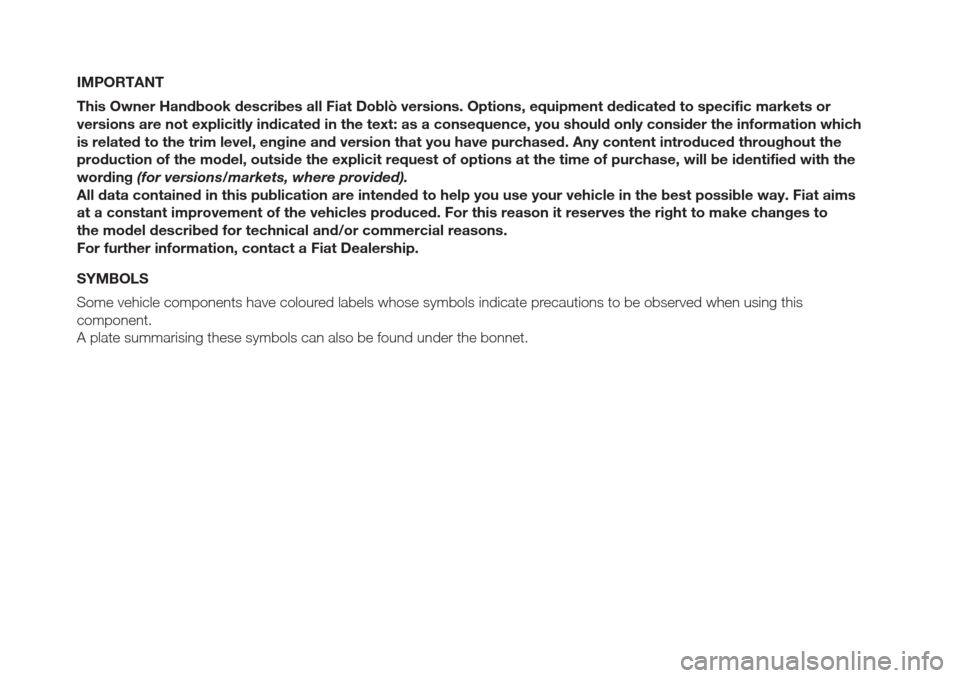
IMPORTANT
This Owner Handbook describes all Fiat Doblò versions. Options, equipment dedicated to specific markets or
versions are not explicitly indicated in the text: as a consequence, you should only consider the information which
is related to the trim level, engine and version that you have purchased. Any content introduced throughout the
production of the model, outside the explicit request of options at the time of purchase, will be identified with the
wording(for versions/markets, where provided).
All data contained in this publication are intended to help you use your vehicle in the best possible way. Fiat aims
at a constant improvement of the vehicles produced. For this reason it reserves the right to make changes to
the model described for technical and/or commercial reasons.
For further information, contact a Fiat Dealership.
SYMBOLS
Some vehicle components have coloured labels whose symbols indicate precautions to be observed when using this
component.
A plate summarising these symbols can also be found under the bonnet.
Page 16 of 300
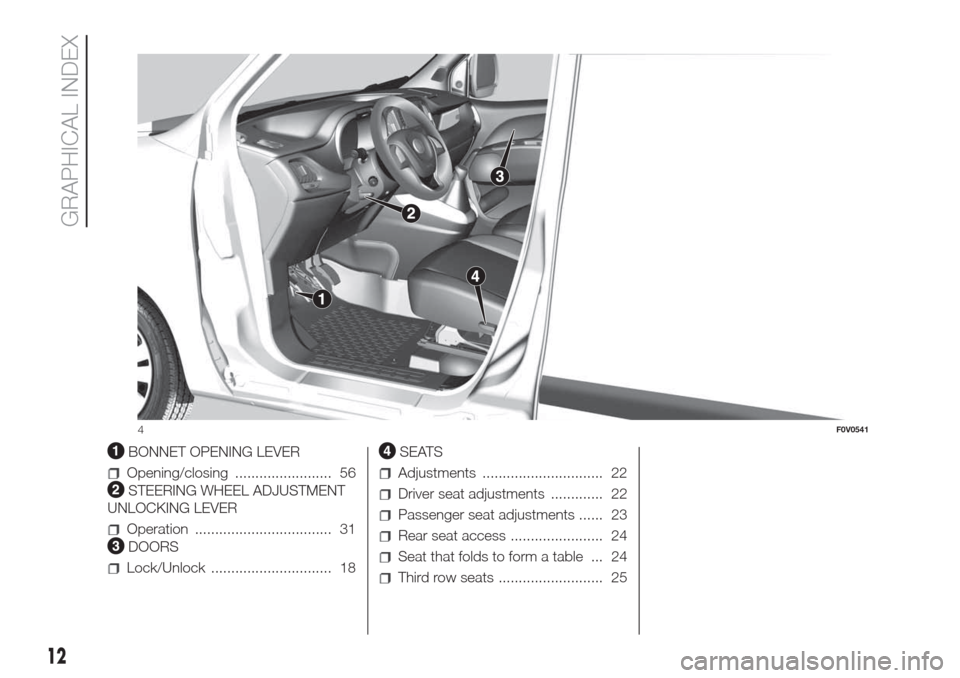
.
BONNET OPENING LEVER
Opening/closing ........................ 56
STEERING WHEEL ADJUSTMENT
UNLOCKING LEVER
Operation .................................. 31
DOORS
Lock/Unlock .............................. 18
SEATS
Adjustments .............................. 22
Driver seat adjustments ............. 22
Passenger seat adjustments ...... 23
Rear seat access ....................... 24
Seat that folds to form a table ... 24
Third row seats .......................... 25
4F0V0541
12
GRAPHICAL INDEX
Page 17 of 300
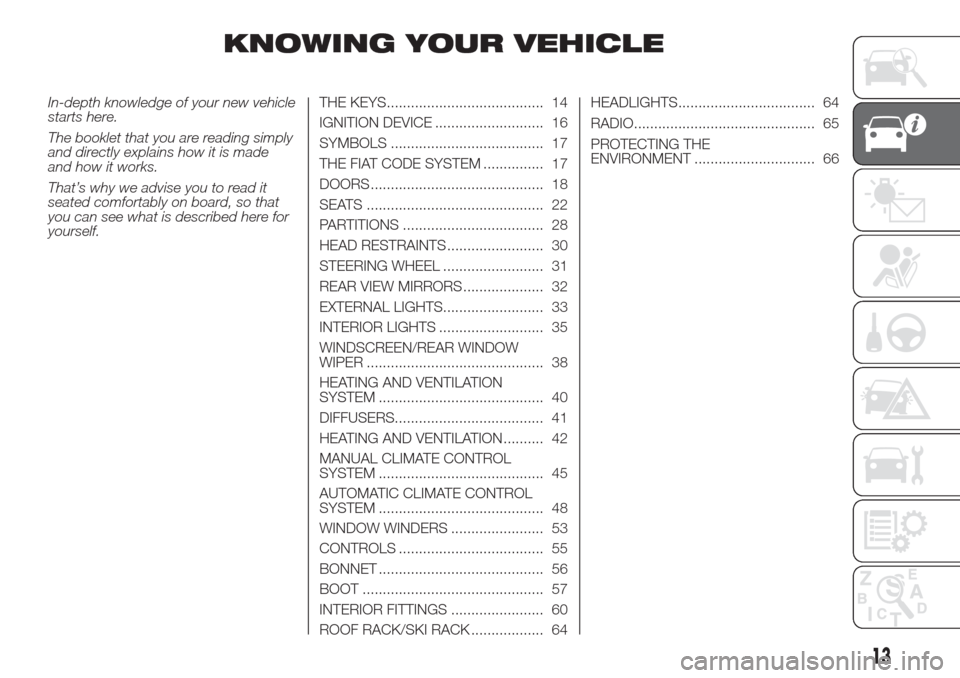
KNOWING YOUR VEHICLE
In-depth knowledge of your new vehicle
starts here.
The booklet that you are reading simply
and directly explains how it is made
and how it works.
That’s why we advise you to read it
seated comfortably on board, so that
you can see what is described here for
yourself.THE KEYS....................................... 14
IGNITION DEVICE ........................... 16
SYMBOLS ...................................... 17
THE FIAT CODE SYSTEM ............... 17
DOORS ........................................... 18
SEATS ............................................ 22
PARTITIONS ................................... 28
HEAD RESTRAINTS ........................ 30
STEERING WHEEL ......................... 31
REAR VIEW MIRRORS .................... 32
EXTERNAL LIGHTS......................... 33
INTERIOR LIGHTS .......................... 35
WINDSCREEN/REAR WINDOW
WIPER ............................................ 38
HEATING AND VENTILATION
SYSTEM ......................................... 40
DIFFUSERS..................................... 41
HEATING AND VENTILATION.......... 42
MANUAL CLIMATE CONTROL
SYSTEM ......................................... 45
AUTOMATIC CLIMATE CONTROL
SYSTEM ......................................... 48
WINDOW WINDERS ....................... 53
CONTROLS .................................... 55
BONNET ......................................... 56
BOOT ............................................. 57
INTERIOR FITTINGS ....................... 60
ROOF RACK/SKI RACK .................. 64HEADLIGHTS.................................. 64
RADIO............................................. 65
PROTECTING THE
ENVIRONMENT .............................. 66
13
Page 21 of 300
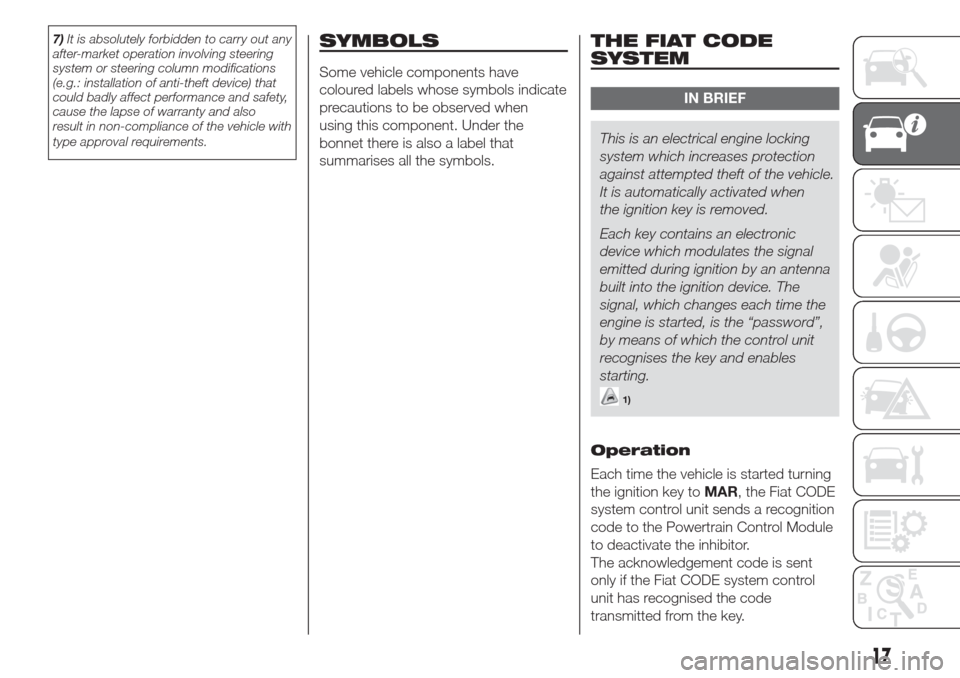
7)It is absolutely forbidden to carry out any
after-market operation involving steering
system or steering column modifications
(e.g.: installation of anti-theft device) that
could badly affect performance and safety,
cause the lapse of warranty and also
result in non-compliance of the vehicle with
type approval requirements.SYMBOLS
Some vehicle components have
coloured labels whose symbols indicate
precautions to be observed when
using this component. Under the
bonnet there is also a label that
summarises all the symbols.
THE FIAT CODE
SYSTEM
IN BRIEF
This is an electrical engine locking
system which increases protection
against attempted theft of the vehicle.
It is automatically activated when
the ignition key is removed.
Each key contains an electronic
device which modulates the signal
emitted during ignition by an antenna
built into the ignition device. The
signal, which changes each time the
engine is started, is the “password”,
by means of which the control unit
recognises the key and enables
starting.
1)
Operation
Each time the vehicle is started turning
the ignition key toMAR, the Fiat CODE
system control unit sends a recognition
code to the Powertrain Control Module
to deactivate the inhibitor.
The acknowledgement code is sent
only if the Fiat CODE system control
unit has recognised the code
transmitted from the key.
17
Page 60 of 300

BONNET
Opening
Proceed as follows:
pull lever A fig. 80 in the direction
indicated by the arrow;
operate lever B fig. 81, lift the
bonnet and, at the same time, release
the supporting rod C fig. 82 from its
catch D, then insert the end of the rod
into housing E in the bonnet (large hole)
and push to safety position (small
hole), as shown in the figure.
30) 31) 32) 33)
Closing
Proceed as follows:
Hold the bonnet up with one hand
and with the other remove rod C from
housing E and fit it back into its catch
D;
Lower the bonnet to approximately
20 centimetres above the engine
compartment and let it come down.
Make sure that the bonnet is
completely closed and not just secured
in safety position. If it is not perfectly
closed, do not try to press the bonnet
down but open it and repeat the
procedure.
34)
WARNING
30)Incorrect positioning of the supporting
rod may cause the bonnet to drop
suddenly. Perform this operation only when
the vehicle is stationary.
31)Before opening the bonnet, make sure
that windscreen wiper arm is not raised,
but is rather positioned against the
windscreen.80F0V0047
81F0V0048
82F0V0049
56
KNOWING YOUR VEHICLE
Page 61 of 300
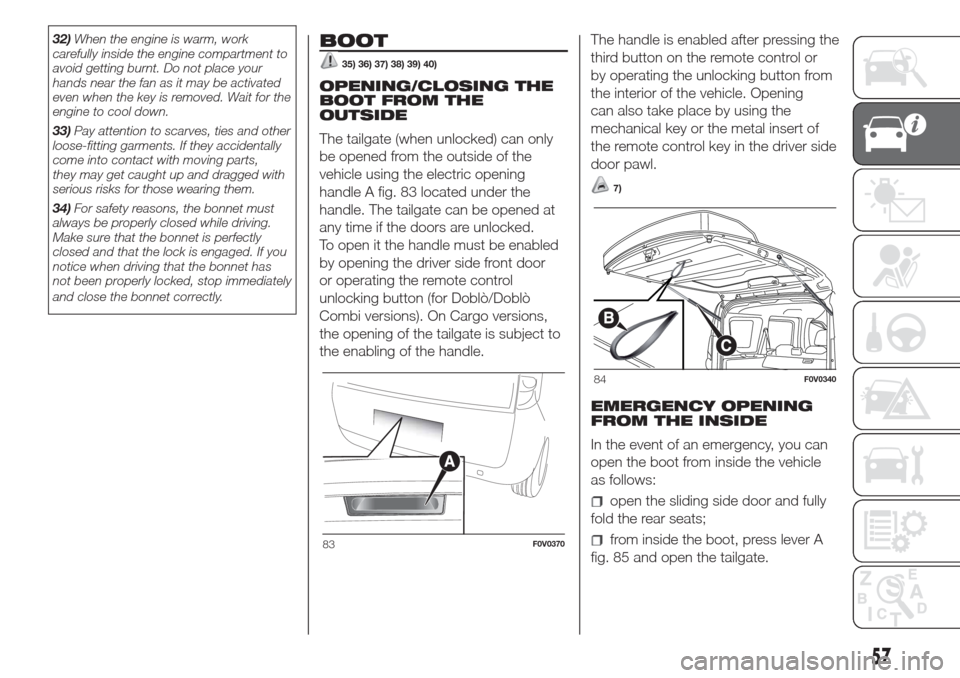
32)When the engine is warm, work
carefully inside the engine compartment to
avoid getting burnt. Do not place your
hands near the fan as it may be activated
even when the key is removed. Wait for the
engine to cool down.
33)Pay attention to scarves, ties and other
loose-fitting garments. If they accidentally
come into contact with moving parts,
they may get caught up and dragged with
serious risks for those wearing them.
34)For safety reasons, the bonnet must
always be properly closed while driving.
Make sure that the bonnet is perfectly
closed and that the lock is engaged. If you
notice when driving that the bonnet has
not been properly locked, stop immediately
and close the bonnet correctly.BOOT
35) 36) 37) 38) 39) 40)
OPENING/CLOSING THE
BOOT FROM THE
OUTSIDE
The tailgate (when unlocked) can only
be opened from the outside of the
vehicle using the electric opening
handle A fig. 83 located under the
handle. The tailgate can be opened at
any time if the doors are unlocked.
To open it the handle must be enabled
by opening the driver side front door
or operating the remote control
unlocking button (for Doblò/Doblò
Combi versions). On Cargo versions,
the opening of the tailgate is subject to
the enabling of the handle.The handle is enabled after pressing the
third button on the remote control or
by operating the unlocking button from
the interior of the vehicle. Opening
can also take place by using the
mechanical key or the metal insert of
the remote control key in the driver side
door pawl.
7)
EMERGENCY OPENING
FROM THE INSIDE
In the event of an emergency, you can
open the boot from inside the vehicle
as follows:
open the sliding side door and fully
fold the rear seats;
from inside the boot, press lever A
fig. 85 and open the tailgate.83F0V0370
84F0V0340
57
Page 137 of 300

VEHICLE INACTIVITY
Versions with dummy pole fig. 150
If the vehicle is inactive, special care
must be taken to disconnect the
battery electrical power supply. This
procedure is carried out by
disconnecting the rapid release
negative terminal A from the negative
false pole B because there is a battery
status monitoring sensor D at the
negative battery pole C which should
never be disconnected except when
the actual battery is replaced.
Versions without
dummy pole fig. 151
In case of car inactivity, special
attention must be paid due to the
disconnection of the battery power
supply.Proceed as follows: detach the
connector A (by pressing button B)
from sensor C for monitoring the status
of the battery installed on the negative
battery pole D. This sensor should
never be disconnected from the pole
except if the battery is replaced.
98)
EMERGENCY STARTING
When jump starting, never connect the
negative lead (–) of the auxiliary battery
to the negative pole C of the vehicle
battery, but rather to either the false
pole B or to an engine/gearbox earth
point fig. 152.
99) 100) 101) 102)
WARNING
98)If the battery needs to be replaced,
always contact a Fiat Dealership. Replace
the battery with a new one of the same
type and specifications.
99)Before opening the bonnet, make sure
that the vehicle is switched off and the
key is in the OFF position. Please follow the
instructions on the decal near the front
crossmember. It is advisable to extract the
key when there are other people in the
vehicle.
149F0V0041150F0V0042
151F0V0218
152F0V0043
133
Page 180 of 300
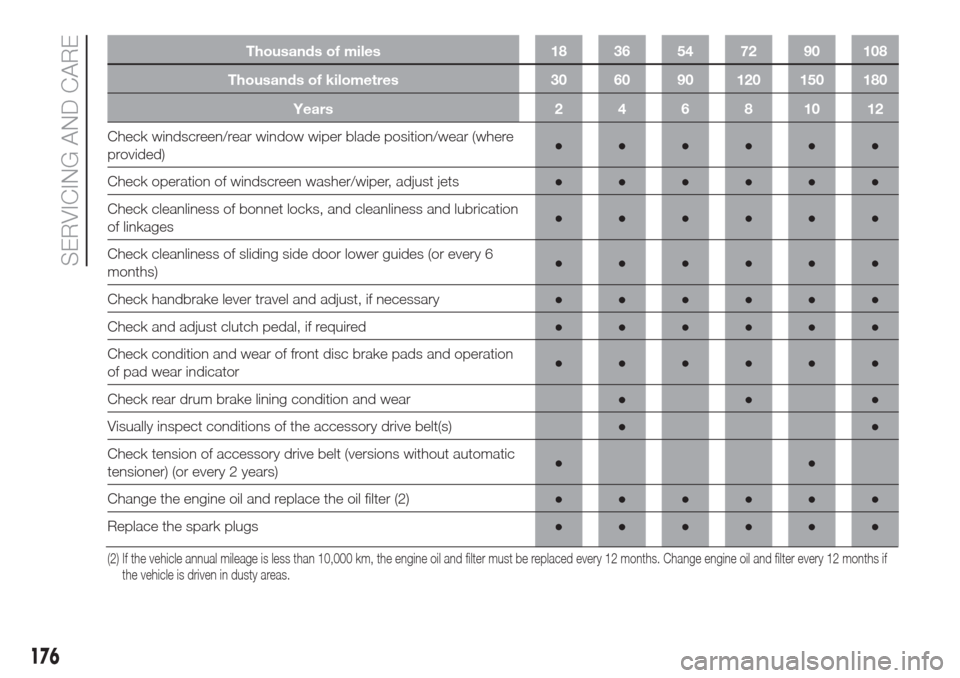
Thousands of miles 18 36 54 72 90 108
Thousands of kilometres 30 60 90 120 150 180
Years 2 4 6 8 10 12
Check windscreen/rear window wiper blade position/wear (where
provided)●●●●●●
Check operation of windscreen washer/wiper, adjust jets●●●●●●
Check cleanliness of bonnet locks, and cleanliness and lubrication
of linkages●●●●●●
Check cleanliness of sliding side door lower guides (or every 6
months)●●●●●●
Check handbrake lever travel and adjust, if necessary●●●●●●
Check and adjust clutch pedal, if required●●●●●●
Check condition and wear of front disc brake pads and operation
of pad wear indicator●●●●●●
Check rear drum brake lining condition and wear●●●
Visually inspect conditions of the accessory drive belt(s)●●
Check tension of accessory drive belt (versions without automatic
tensioner) (or every 2 years)●●
Change the engine oil and replace the oil filter (2)●●●●●●
Replace the spark plugs●●●●●●
(2) If the vehicle annual mileage is less than 10,000 km, the engine oil and filter must be replaced every 12 months. Change engine oil and filter every 12months if
the vehicle is driven in dusty areas.
176
SERVICING AND CARE
Page 183 of 300
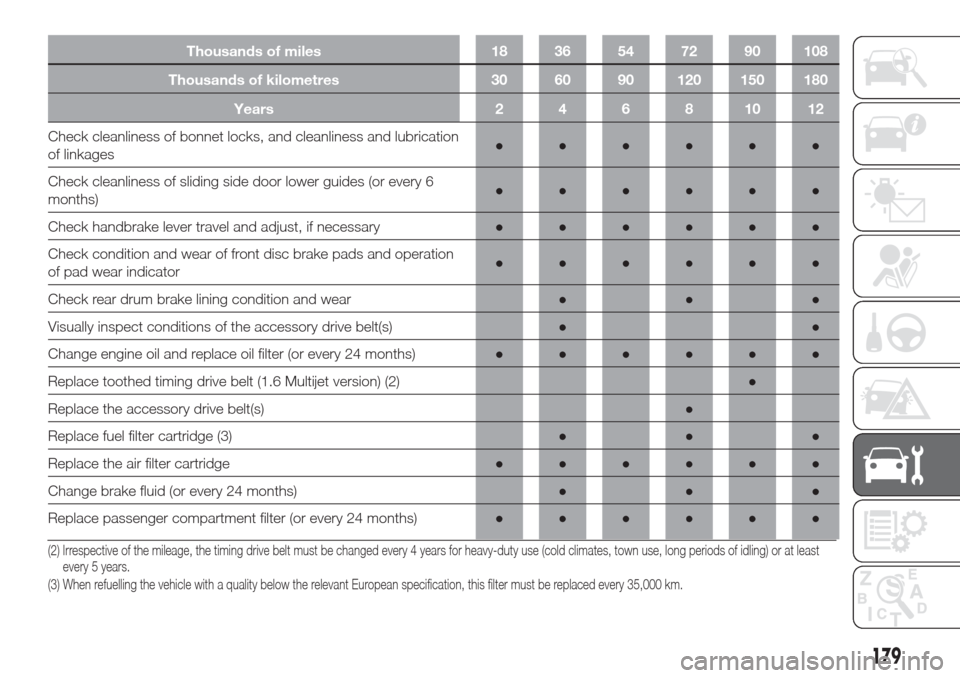
Thousands of miles 18 36 54 72 90 108
Thousands of kilometres 30 60 90 120 150 180
Years 2 4 6 8 10 12
Check cleanliness of bonnet locks, and cleanliness and lubrication
of linkages●●●●●●
Check cleanliness of sliding side door lower guides (or every 6
months)●●●●●●
Check handbrake lever travel and adjust, if necessary●●●●●●
Check condition and wear of front disc brake pads and operation
of pad wear indicator●●●●●●
Check rear drum brake lining condition and wear●●●
Visually inspect conditions of the accessory drive belt(s)●●
Change engine oil and replace oil filter (or every 24 months)●●●●●●
Replace toothed timing drive belt (1.6 Multijet version) (2)●
Replace the accessory drive belt(s)●
Replace fuel filter cartridge (3)●●●
Replace the air filter cartridge●●●●●●
Change brake fluid (or every 24 months)●●●
Replace passenger compartment filter (or every 24 months)●●●●●●
(2) Irrespective of the mileage, the timing drive belt must be changed every 4 years for heavy-duty use (cold climates, town use, long periods of idling) or at least
every 5 years.
(3) When refuelling the vehicle with a quality below the relevant European specification, this filter must be replaced every 35,000 km.
179
Page 185 of 300
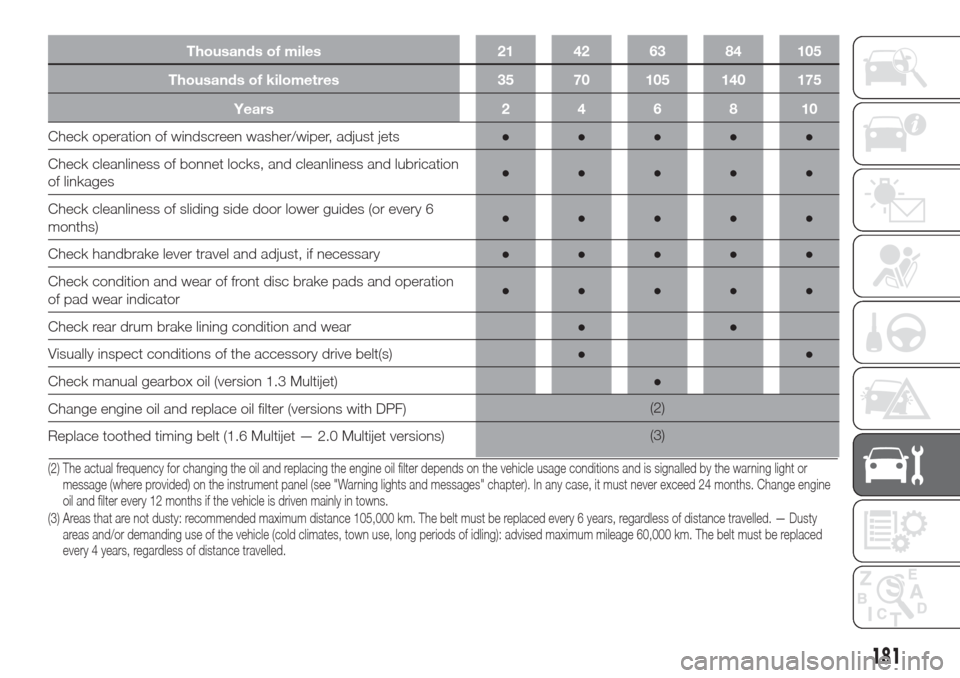
Thousands of miles 21 42 63 84 105
Thousands of kilometres 35 70 105 140 175
Years246810
Check operation of windscreen washer/wiper, adjust jets●●●●●
Check cleanliness of bonnet locks, and cleanliness and lubrication
of linkages●●●●●
Check cleanliness of sliding side door lower guides (or every 6
months)●●●●●
Check handbrake lever travel and adjust, if necessary●●●●●
Check condition and wear of front disc brake pads and operation
of pad wear indicator●●●●●
Check rear drum brake lining condition and wear●●
Visually inspect conditions of the accessory drive belt(s)●●
Check manual gearbox oil (version 1.3 Multijet)●
Change engine oil and replace oil filter (versions with DPF)(2)
Replace toothed timing belt (1.6 Multijet — 2.0 Multijet versions)(3)
(2) The actual frequency for changing the oil and replacing the engine oil filter depends on the vehicle usage conditions and is signalled by the warning light or
message (where provided) on the instrument panel (see "Warning lights and messages" chapter). In any case, it must never exceed 24 months. Change engine
oil and filter every 12 months if the vehicle is driven mainly in towns.
(3) Areas that are not dusty: recommended maximum distance 105,000 km. The belt must be replaced every 6 years, regardless of distance travelled. — Dusty
areas and/or demanding use of the vehicle (cold climates, town use, long periods of idling): advised maximum mileage 60,000 km. The belt must be replaced
every 4 years, regardless of distance travelled.
181